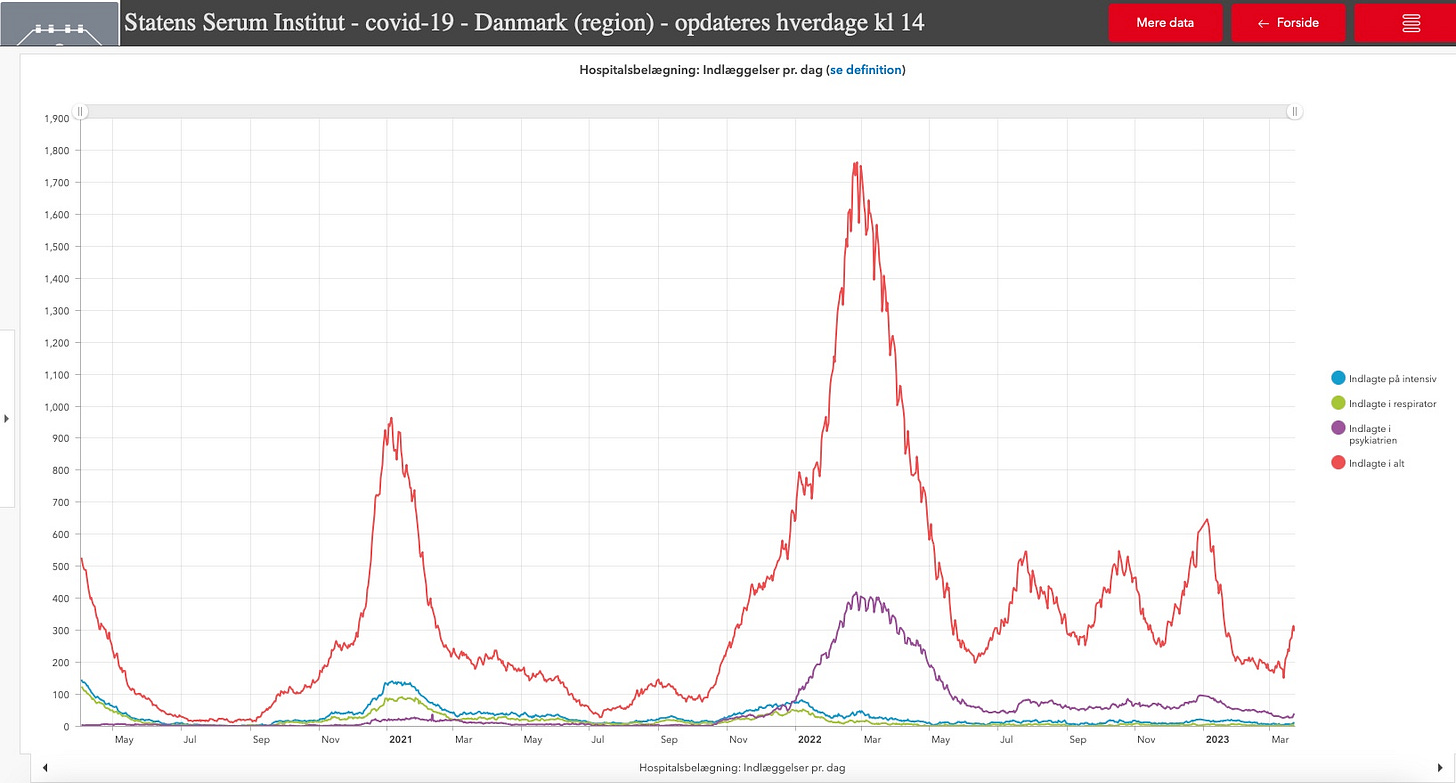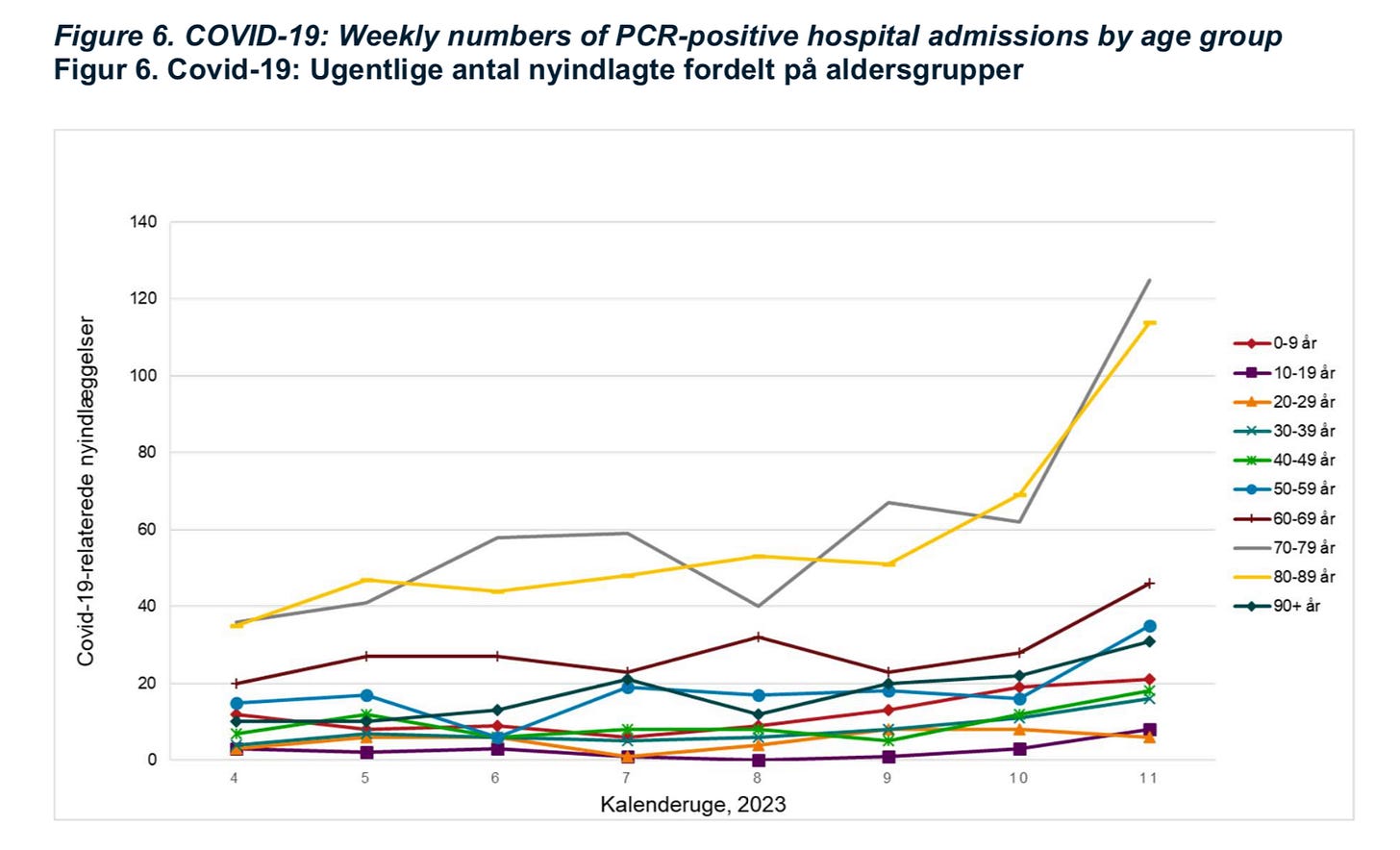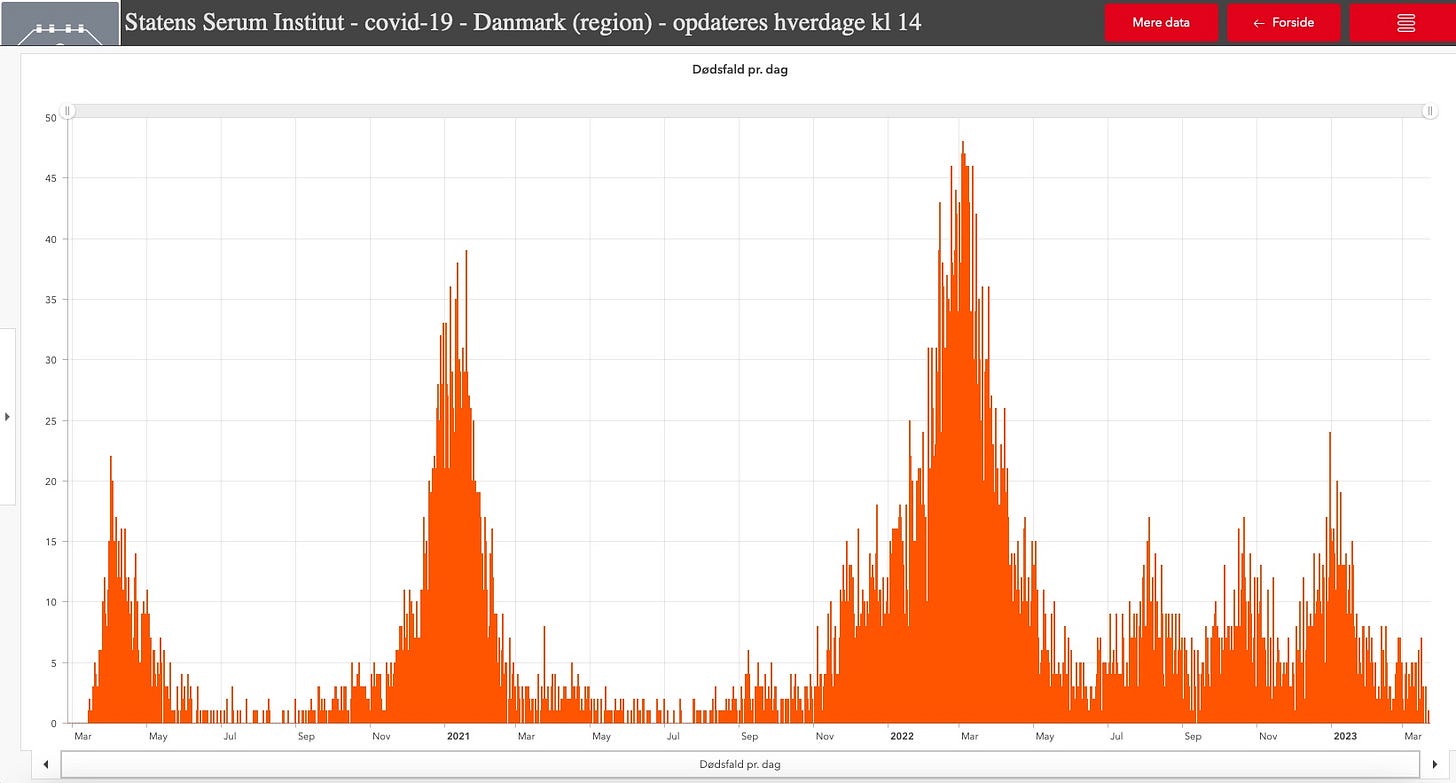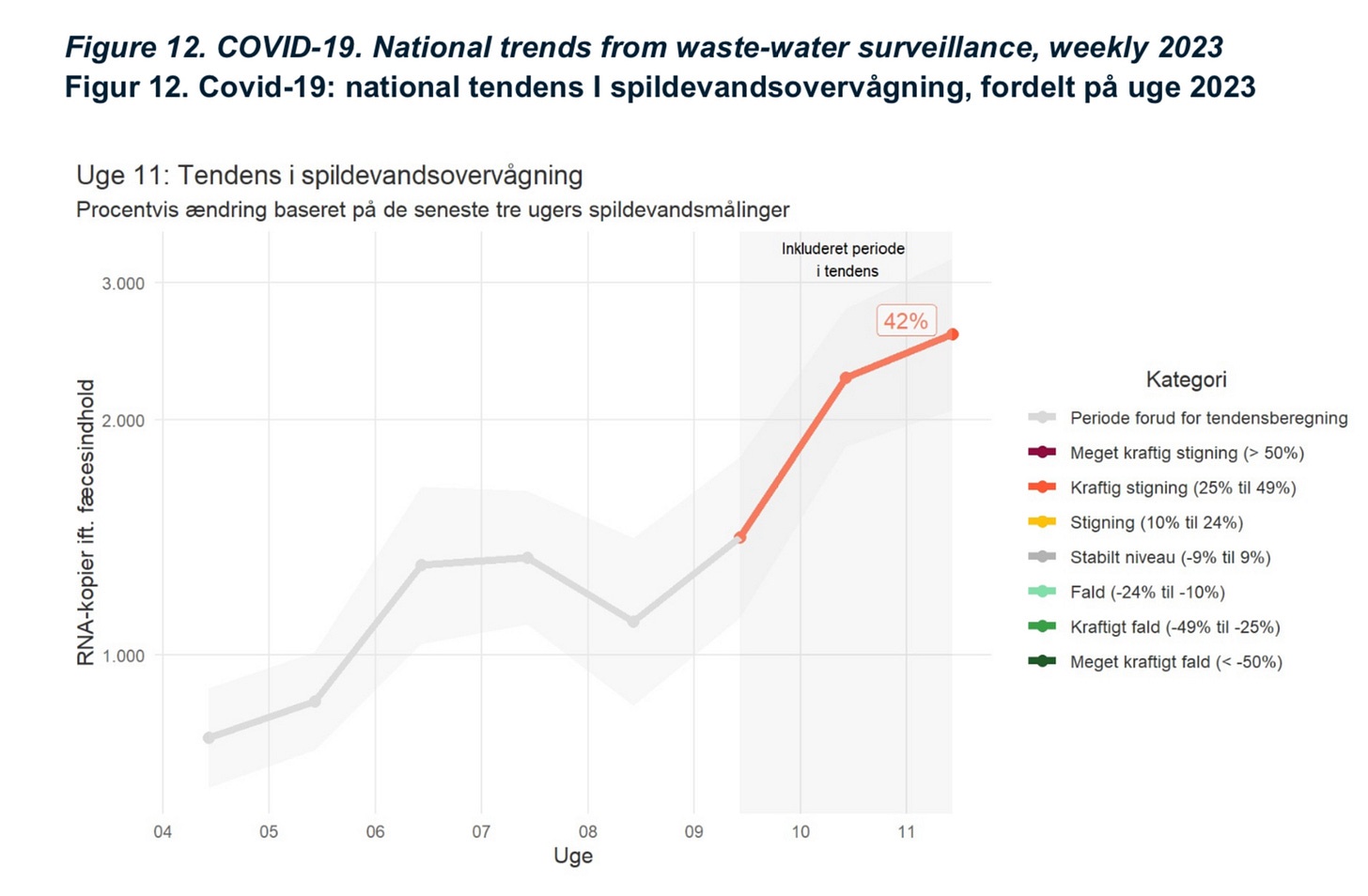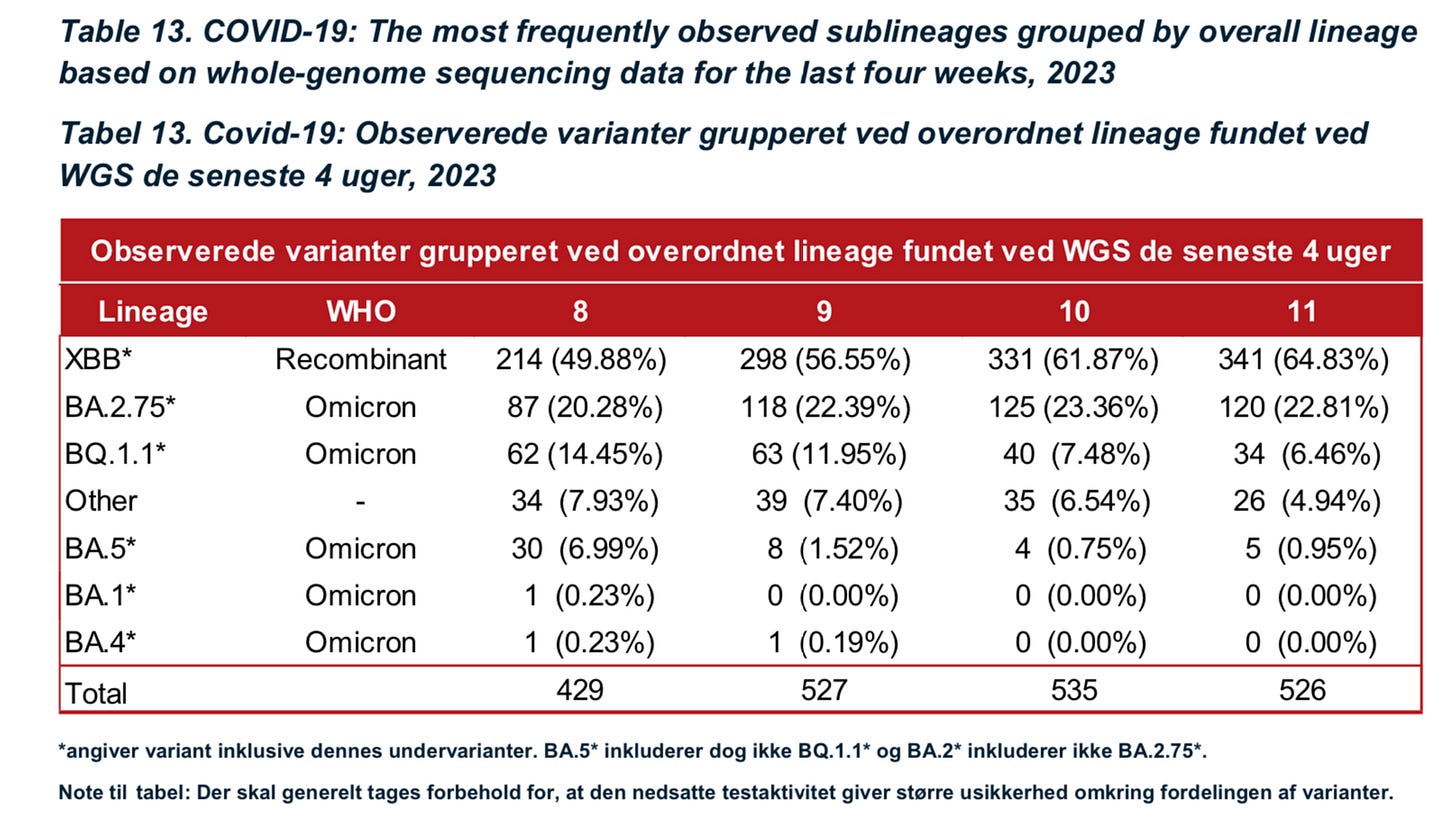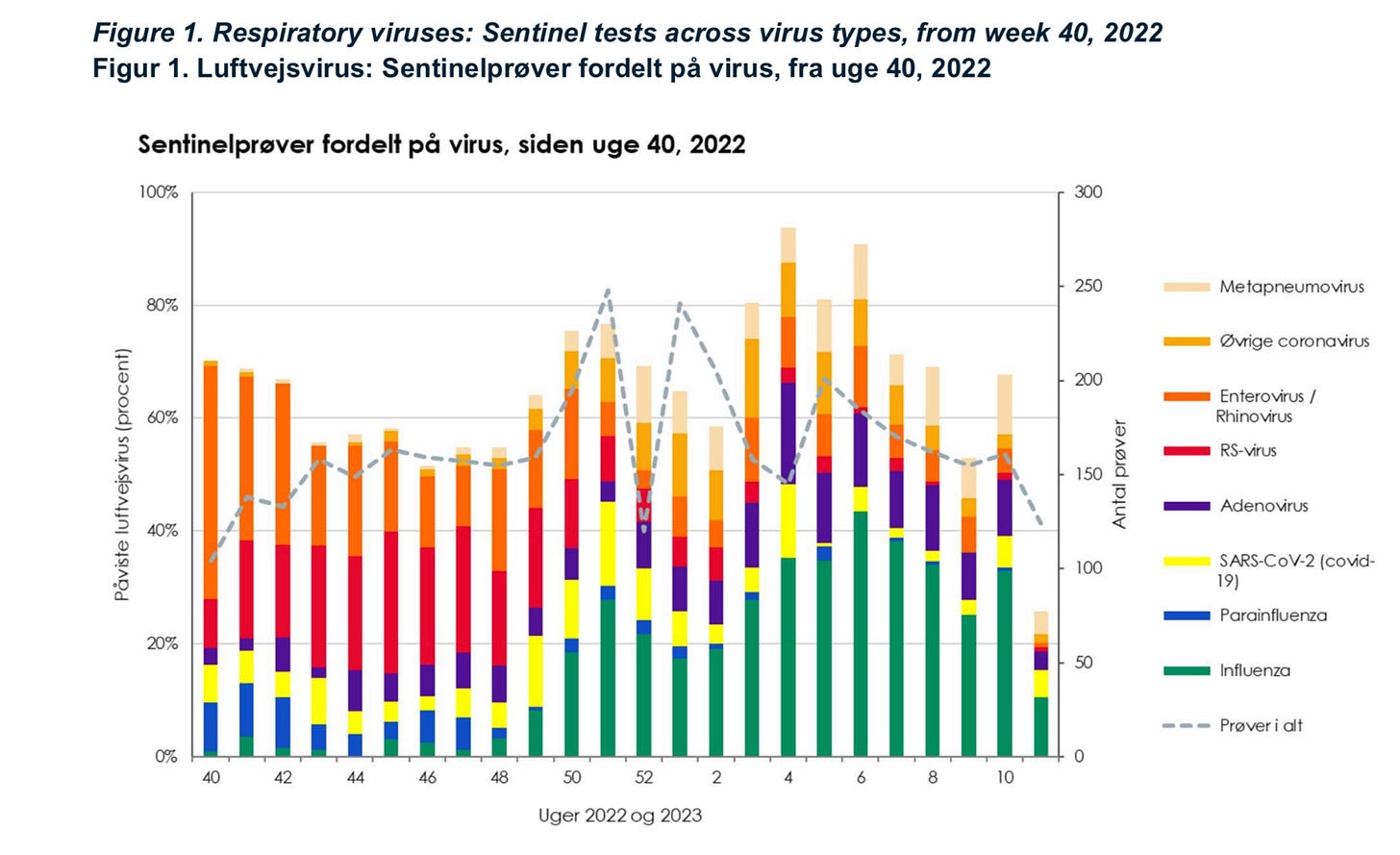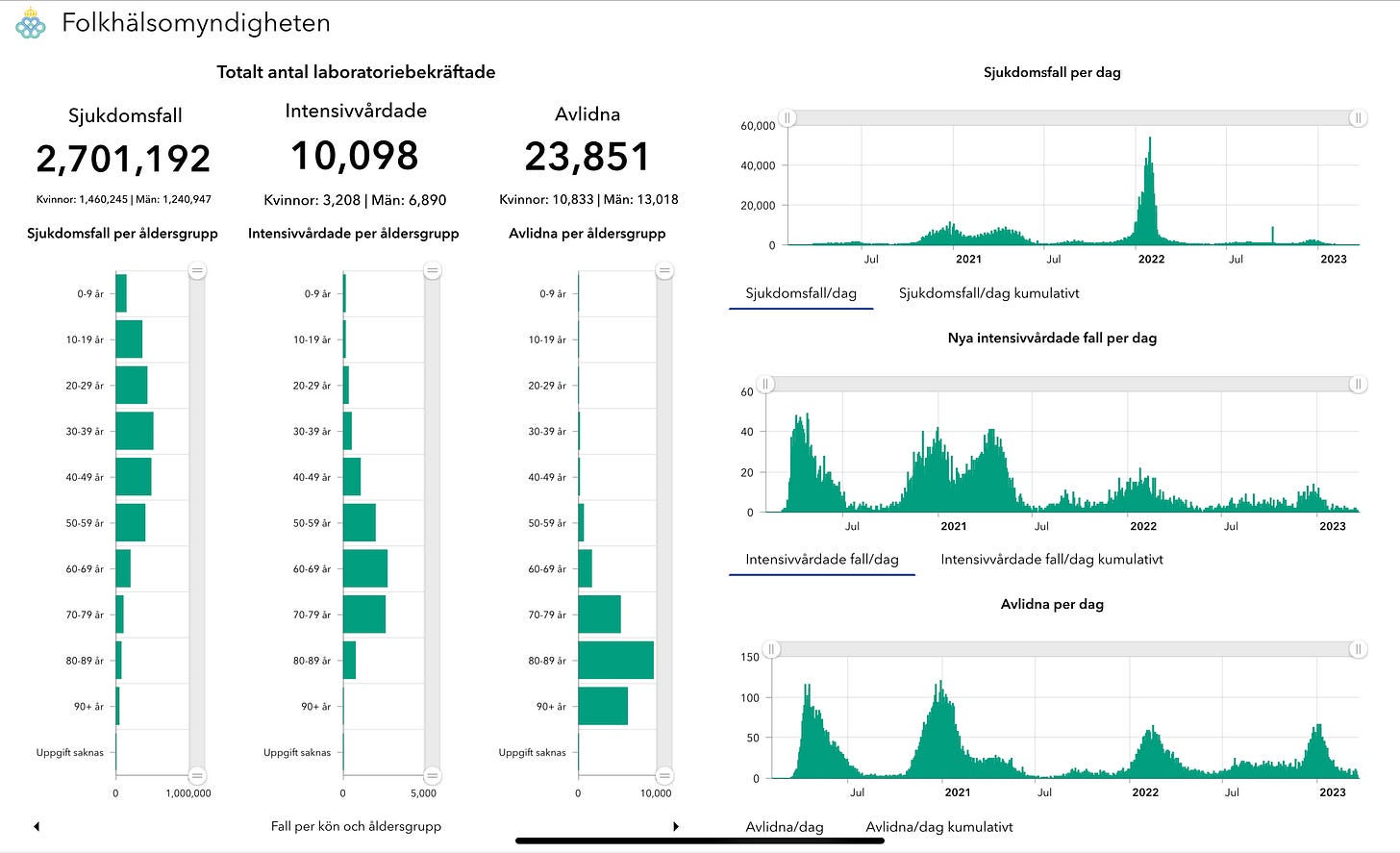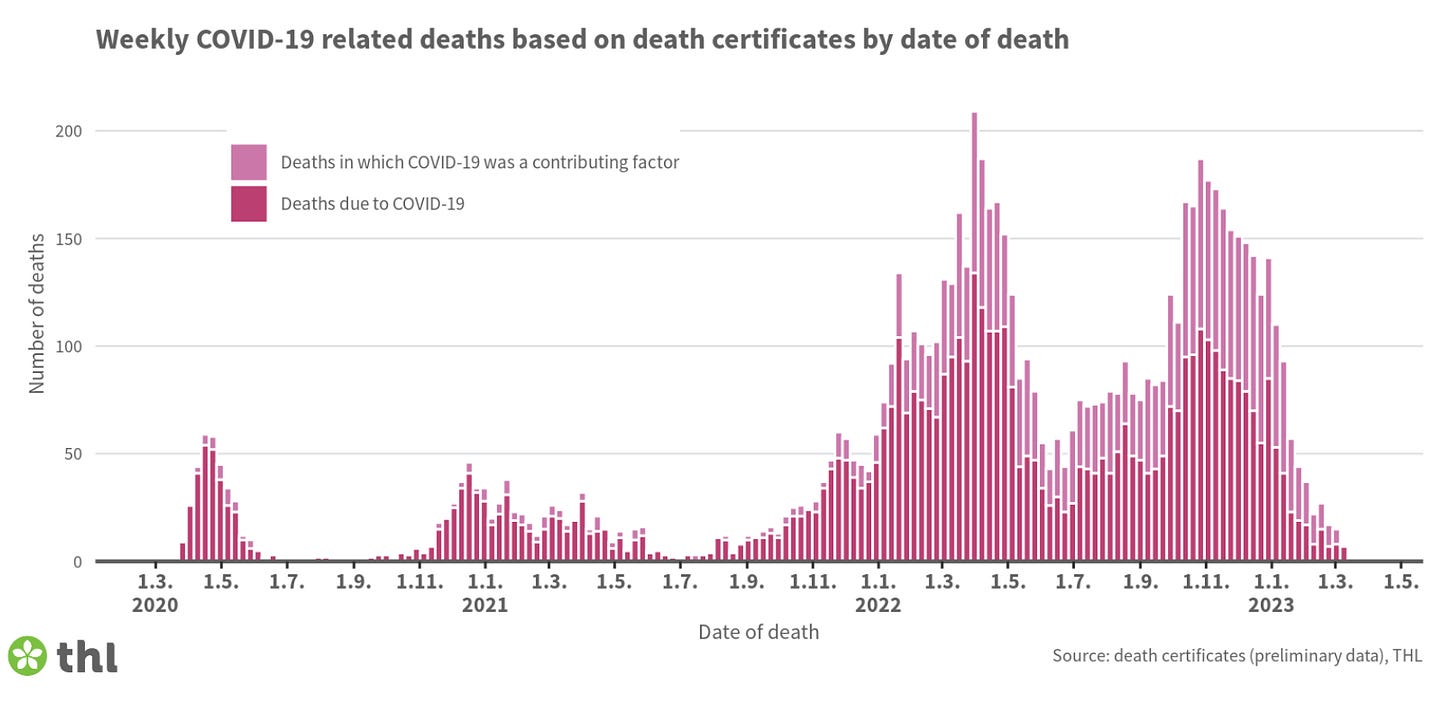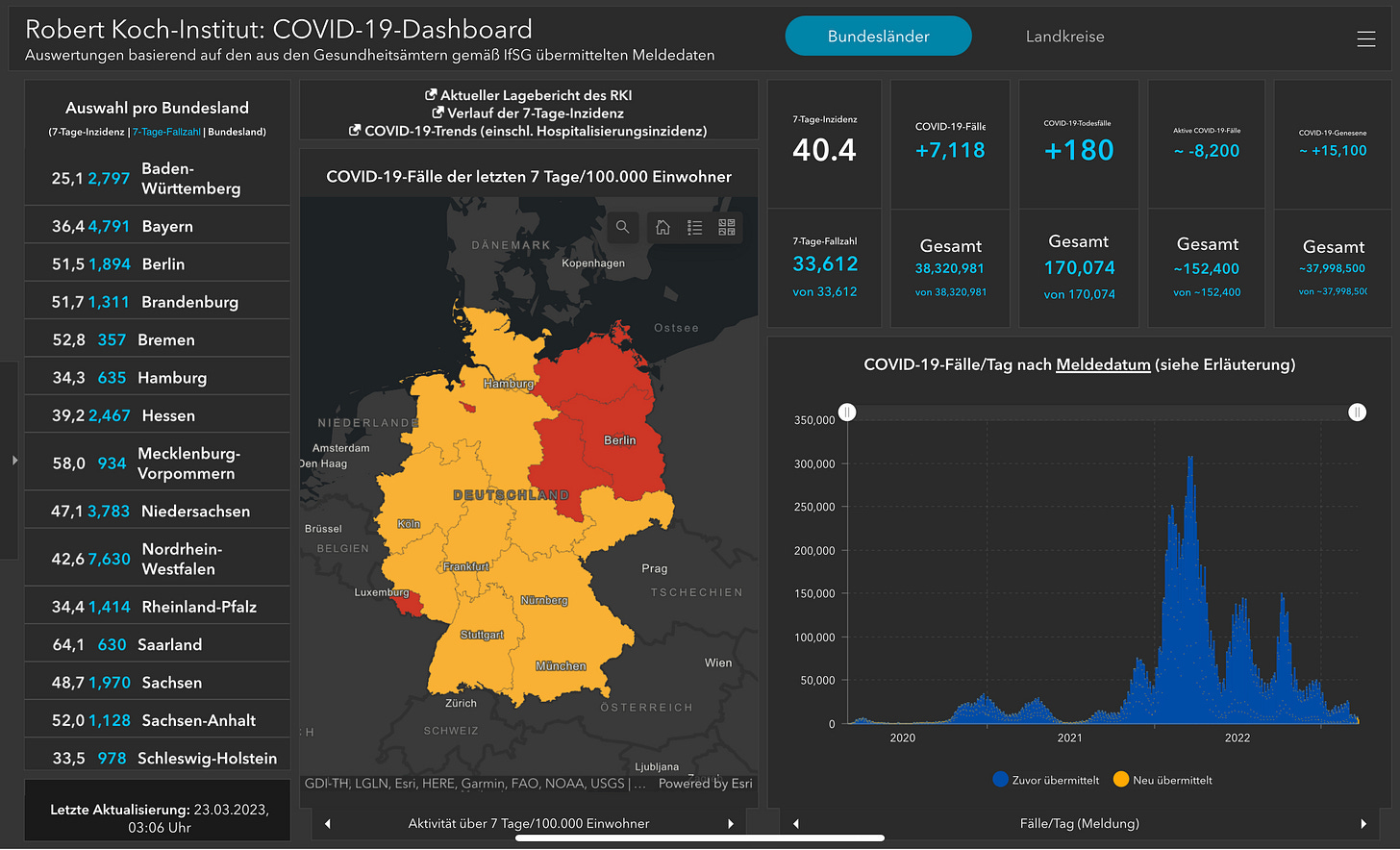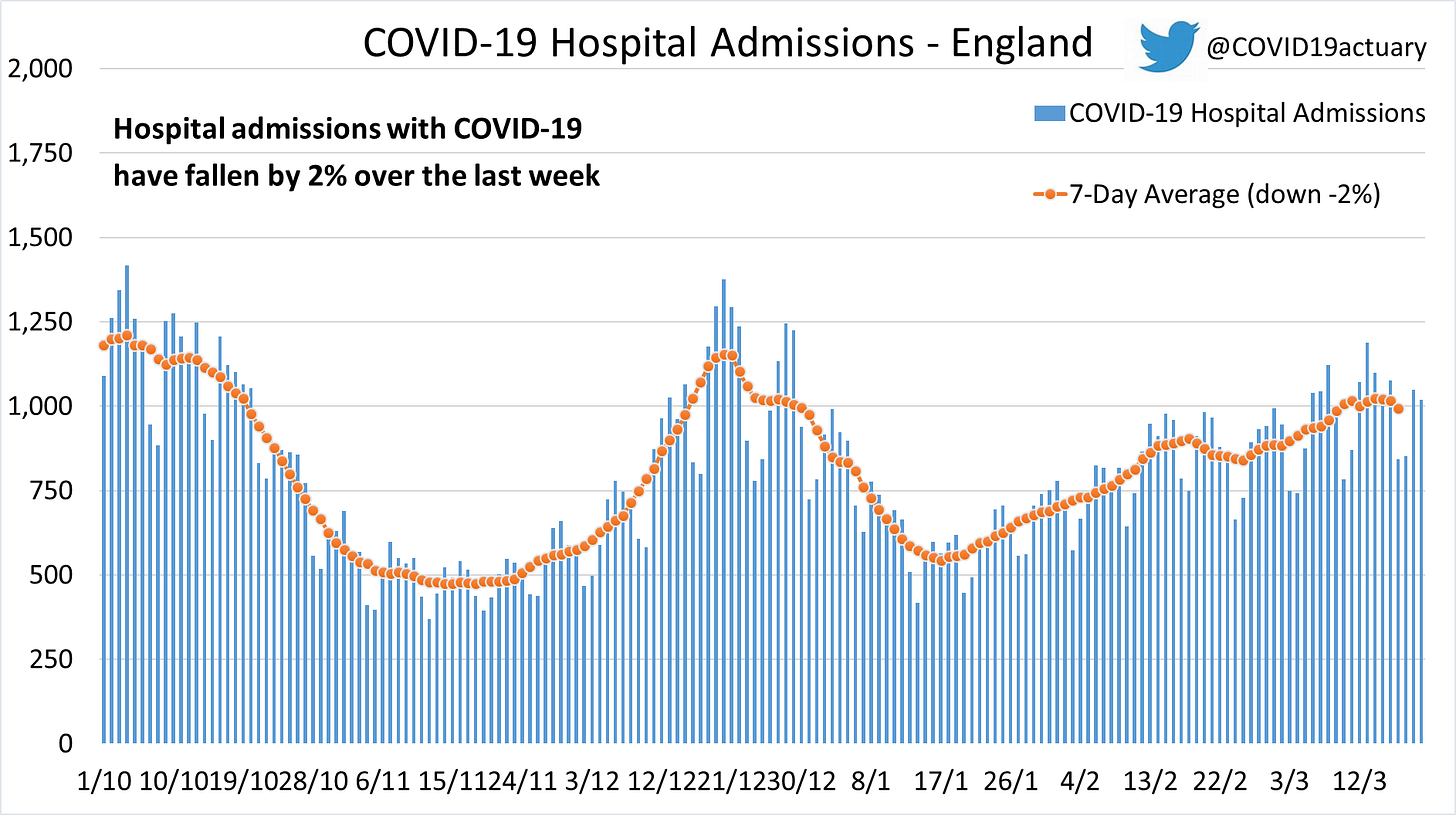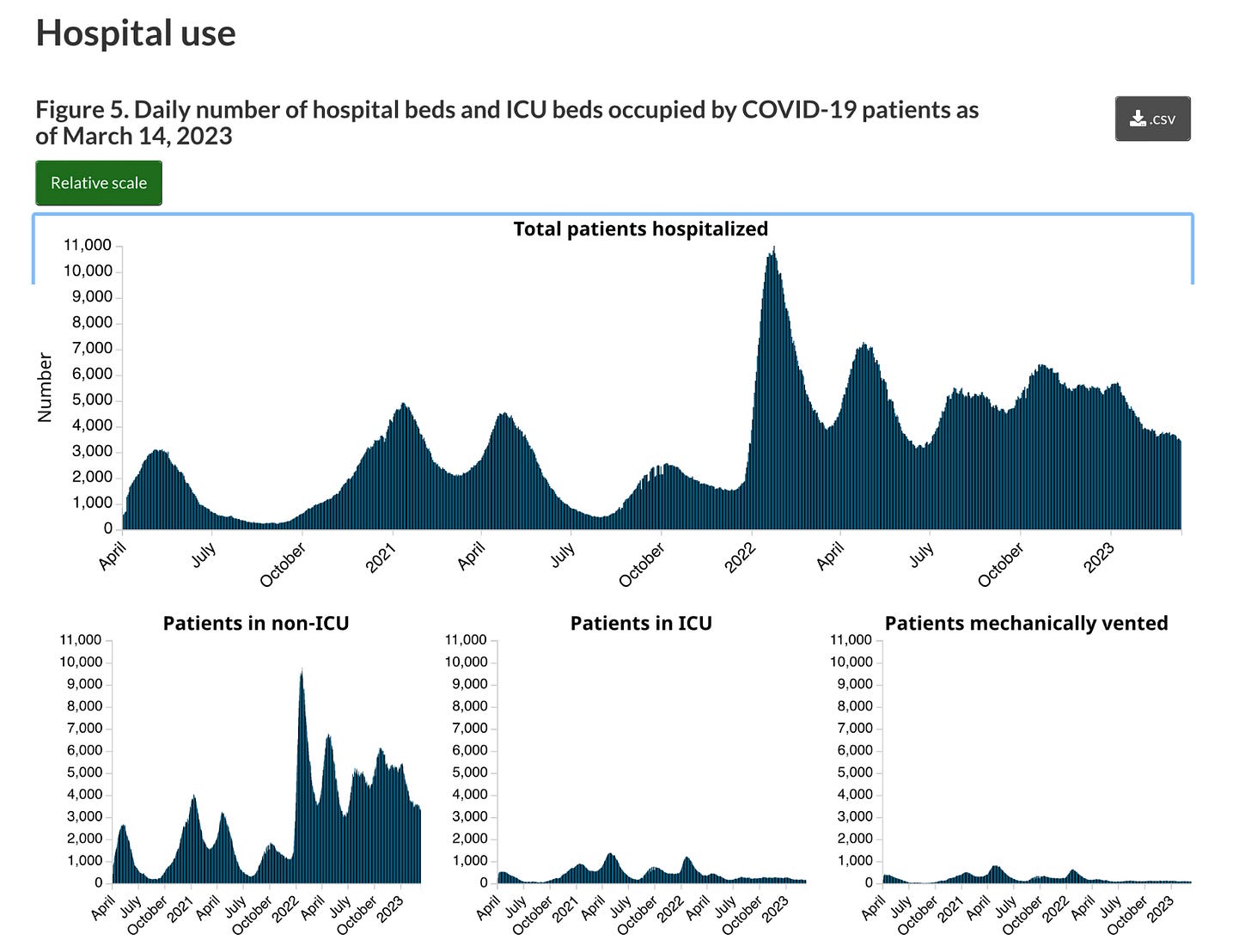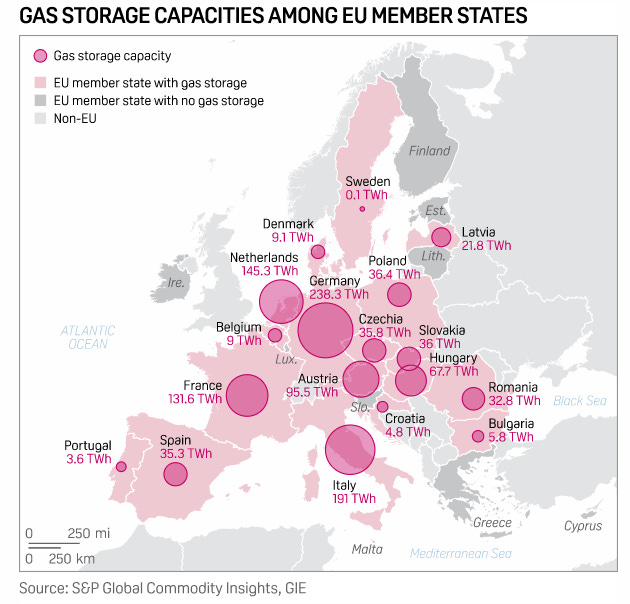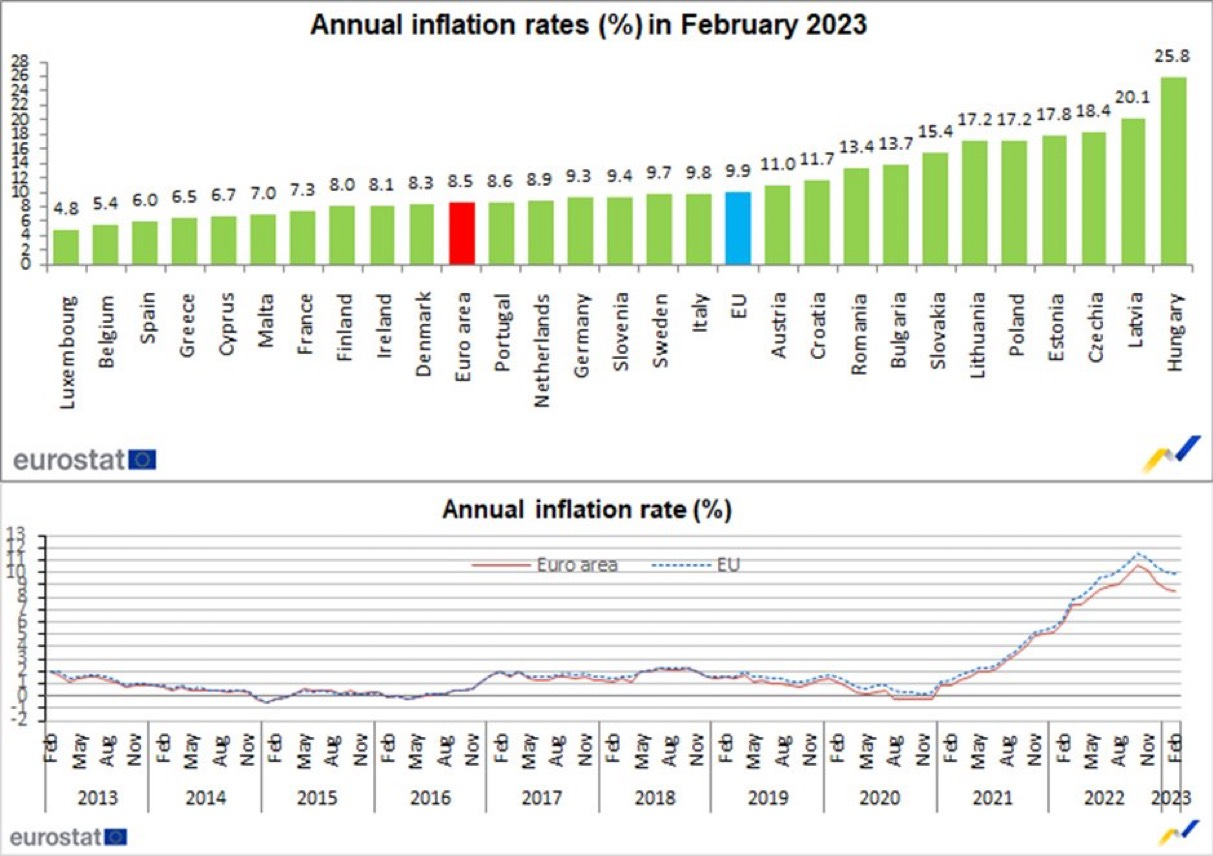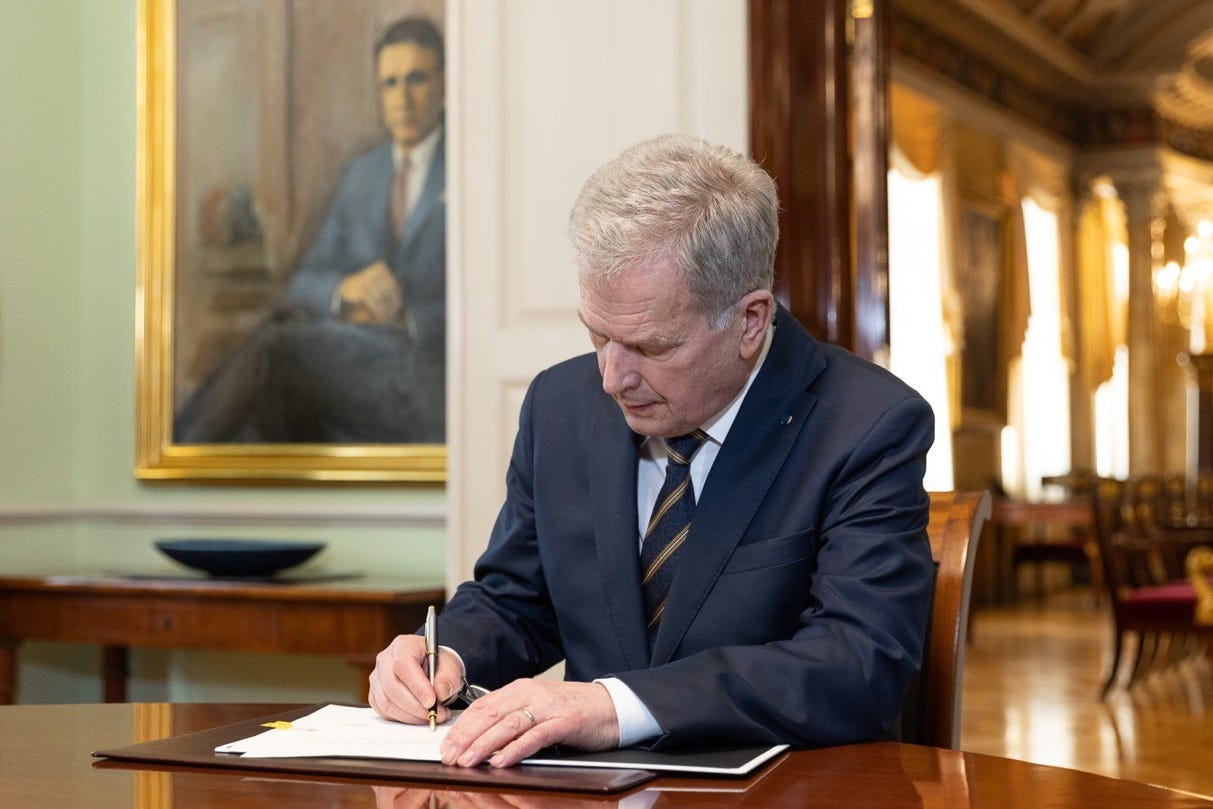Editors Note - Informeret is taking a two week pause as I am traveling back to Canada to visit family and take care of some business. We will publish next on April 13.
🦠Pandemic🦠
🇩🇰
Denmark will mothball its public COVID PCR testing program on March 31. The Statens Serum Institute says PCR testing will only be available after March 31 at either private testing clinics or if deemed necessary by a Doctor.
The institute says it will continue to monitor pandemic developments through things like COVID wastewater surveillance and reports from general practitioners. But in practicality, once PCR testing and the sequencing of positive tests ends Denmark will be largely blind to pandemic developments and emerging new variants.
-
COVID hospitalizations (297) dropped day to day (-17) while ICU numbers (9) also eased (-2) of those; the number on a ventilator (3) dipped slightly (-1).
But in its latest weekly pandemic update, the Statens Serum Institute says hospitalizations jumped last week, with 420 admissions, 170 more than the week before. While admissions increased across several age groups, seniors between 70 and 89 years old once again suffered the worst of it.
-
There were another two coronavirus deaths yesterday. Last week, the SSI says it recorded 22 fatalities, down from the 30 lives lost the week prior. The SSI says there were no increases in excess mortality in any age group.
-
COVID wastewater surveillance continues to record increasing virus activity across Denmark. The SSI says wastewater coronavirus activity has “risen sharply” over the last three weeks.
Keep in mind the number of wastewater surveillance sites in Denmark has been reduced.
-
XBB recombinant variants are now dominant in Denmark, making up 65% of what few positive tests are still being sequenced. Of those, the XBB.1.5 variant alone accounts for 43%.
“It should generally be noted that the reduced test activity gives greater uncertainty about the distribution of variants. There is no evidence that XBB.1.5 is associated with more severe disease.”
-
Looking at the less reliable indicators, the number of confirmed infections increased last week, as did the COVID incidence rate as it rose from 15 cases per 100,000 people up to 23. The positivity percentage also increased from 11.1% to 15.5%. Even the number of PCR tests went up by 8.5% last week.
Looking at it by age, seniors 70 to 79 years old had the highest positivity percentage, with 19%. Seniors over 80 had the highest incidence rate per 100,000 people at 61. Infection numbers among vulnerable seniors in care eased week to week, with 28 confirmed cases last week, 11 fewer than the week before. While case number fell, hospitalizations went the other direction, with 25 nursing home residents admitted to the hospital for a severe infection last week. That is six more than the week prior.
-
While pandemic numbers push upward again, the Statens Serum Institute is not overly concerned.
SSI Senior Physician Bolette Søborg:
“However, although the current increase is significant, it is still less than half as many as during the last three smaller infection waves since the summer of 2022. It is not unexpected that we have a new smaller infection wave here in the early spring. But now we are moving towards warmer temperatures, so we at the SSI are not particularly worried at the moment.”
-
The Statens Serum Institute continues to track vaccine efficacy for the latest variant-specific round of booster doses. It says people who received a 4th dose with a bivalent vaccine in the fall booster dose campaign are “well protected against hospitalizations and death due to COVID.” However, it adds that protection against hospitalization does seem to diminish over time.
Among the booster dose target group, it was estimated that those who recorded a bivalent booster are approximately 65% better protected against a severe infection resulting in hospitalization and 74% better protected against death from infection than those with just three doses.
-
The Danish National Health Board is hailing a successful fall vaccination campaign that combined COVID booster doses, flu shots, and pneumococcal vaccination. It says with over 3.7 million vaccinations administered, the operation and how it was organized was a big success.
Section Leader Kirstine Moll Harboe:
"We have had a very high level of support for vaccination against both coronavirus and influenza, especially among the oldest and most vulnerable. Compared to other European countries, we are at the very top, and we should be proud of that. The population has welcomed the vaccination centers, and many used the opportunity to book vaccinations online. Now we must build on those good experiences.”
However, the authority notes that there were still some challenges. A report on the vaccination campaign has been compiled and handed to the Danish Health Authority and the Task Force for National Seasonal Vaccination Programmes. The successes and any lessons learned will then be used for the next booster dose campaign that will likely begin again this fall.
-
Hundreds of thousands of dollars worth of pandemic supplies and equipment will have to be destroyed in Denmark’s 2nd largest city, Aarhus. According to a report from Aarhus Stiftstidende, 4,500 pallets of masks, gloves, face shields, and other protective gear, along with 5,300 pallets of hand sanitizer, are getting tossed because the best-before date has passed. The hand sanitizer alone is worth about 2.5 million Danish kroner (almost $600,000 Cdn). This joins millions of kroner worth of pandemic supplies already destroyed across Denmark due to their shelf life expiring.
-
Denmark’s sentinel surveillance system indicates that overall respiratory infections increased slightly last week. Influenza infections accounted for the most detected viruses, followed by adenovirus and metapneumovirus.
Last week, there was a slight increase in influenza A strain infections while B strain activity remained stable. There was also a slight increase in flu-related hospitalizations.
RS virus infections and related hospital admissions were stable and low last week.
🇸🇪
Sweden added 961 new infections (wildly underreported) and another 38 corona deaths in the last week.
COVID hospitalizations (467) dipped slightly (-18) while ICU numbers (7) crept up (+1).
-
The Swedish Public Health Agency says 2022 was closer to normal in Sweden with increasing cases of infectious diseases other than coronavirus, close to what the country would see before the pandemic. The agency examined infectious disease numbers last year and noted an increase, especially in fall and winter. It puts this down to viruses being passed around as people traveled, visited, and generally increased social contacts as COVID restrictions fell by the wayside.
State Epidemiologist Anders Lindblom:
“During December, the spread of coronavirus, influenza, and the RS virus coincided, which led to many falling ill. It is likely that the population's immunity to several infectious diseases had decreased during the pandemic, which means that more people are susceptible to infections when contacts increased.”
🇫🇮
Finland registered 962 infections and 38 more virus deaths in its latest weekly pandemic report.
-
At first blush, bivalent vaccine booster doses seem to be very effective at reducing severe infections among vulnerable seniors that result in hospitalization or death. The Finnish Institute for Health conducted a study following well over a million seniors and those in high-risk groups over five months.
The study found that the variant-specific booster doses reduced severe infections among vulnerable seniors. But, it also concluded that vaccine efficacy did begin to decline two months after being dosed.
Expert Doctor Eero Poukka:
“Compared to the early days of the pandemic, the risk of severe cases of coronavirus infections among the elderly and those belonging to high-risk groups has decreased considerably. Towards the end of last year, the increase in the number of severe infections was more related to the large overall number of cases.”
As for the drop in vaccine-induced protections two months after vaccination.
“However, the relative decrease in the protective effect of the variant-tailored vaccine does not mean that the risk of severe infections is significant after two months. There is still very little research literature on the duration of the protective effect of variant-tailored vaccines. Before final conclusions, the analysis should be repeated over a longer period of time and with other research settings.”
Among younger people in high-risk populations, the bivalent booster dose did not seem to make much of a difference. The institute suggests “research bias may be associated with this finding.”
Statistician Ulrike Baum:
“COVID patients confirmed with a home test cannot be identified on the basis of national registers. These individuals were less likely to seek out a bivalent booster vaccine. However, they had a hybrid immunity from previous vaccines and from being previously infected, which provides excellent protection against severe infections. This can explain why those who received the bivalent booster did not have a lower risk of severe infection than the comparison group that had not had a variant-specific booster.”
The health agency says the current pandemic situation in Finland is calm.
Eero Poukka:
“There is currently no need for extensive booster vaccinations at the population level in Finland because there are few COVID cases. From the point of view of society, population-level vaccinations require a lot of resources, and when considering large-scale vaccinations, it is important to assess the relationship between the necessary resources and its effectiveness.”
🇸🇪 🇩🇰 🇳🇴
According to a new Nordic study, pregnant women who ended up in hospital with severe COVID infections generally had a few things in common. Using the robust public health registries in Denmark, Norway, and Sweden, the study examined cases of pregnant women admitted to intensive care due to coronavirus infection.
It concluded these were generally very rare instances in all three Nordic countries. But when they did happen, the women were likely unvaccinated. For example, the study found that only 7% of pregnant women admitted to an ICU for a severe infection had been vaccinated. They were also from countries outside Scandinavia and were more likely to have less financial means and lower education levels. In addition, women admitted to ICU for COVID had a higher risk of adverse pregnancy outcomes.
The study even found that the Delta variant wave resulted in most overall cases of severely infected pregnant women needing intensive care.
The study can be found HERE.
🇩🇪
Germany recorded 7,118 new infections and suffered another 180 pandemic deaths in its daily Thursday report.
It added 1,687 more COVID hospitalizations while ICU numbers (1,238) dropped (-42). As a percentage of all intensive care beds in the country, coronavirus patients use 5.9%.
🇬🇧
Pandemic hospitalizations have dipped by 2% in the last week, according to the COVID Actuaries Response Group. Admissions rose in the south-west, midlands, and eastern England but dropped everywhere else.
The reinfection rate, or R0, has fallen to 1.
🇨🇳
After refusing to allow Pfizer/BioNTech and Moderna’s mRNA COVID vaccines to be used in China, the country’s health regulator has approved a made-in-China mRNA vaccine. The vaccine from CSPC Pharmaceutical Group has received emergency use authorization in China. The company says human trials produced good results when used as a booster dose for those who had already received the basic vaccine doses. It adds that there were “substantially lower” adverse effects from vaccination among seniors as compared to adult test groups.
Chinese vaccines so far has proven to be much less effective at preventing severe infections, hospitalization, and death than the western mRNA doses. That, combined with meager vaccination rates and its COVID zero policy, have proven disastrous for the country.
🇨🇦
The Public Health Agency of Canada has reported 8,510 new infections and another 136 pandemic deaths pushing the total to date COVID death toll to 51,800 lives lost.
The seven-day positivity percentage is 11.4%.
Pandemic hospitalizations continue to ease across Canada. In the week ending March 14, coronavirus patients’ total number of hospital beds dropped by 249 to 3,437 beds in use. General admissions saw the biggest decline going from 3,528 to 3,294 COVID patients. The number of severe infection cases in an ICU fell slightly to 143, 15 fewer than the previous week. The number of people on a ventilator also decreased by nine to 77.
⚡️Energy Crisis⚡️
🇪🇺
As winter temperatures end and things begin to warm up, gas demand across the European Union has begun to ease. As of March 18, EU gas reserves were at 55.7%, down slightly from 56.6% the week before. This puts the EU in a very good position to build its gas reserves back up. As a matter of fact, last Saturday, the EU added more gas into storage as demand dropped, and the window began to open for the serious work of building reserves back up before the next winter arrives.
Among the individual countries, France (29.2%), and Belgium (31.1%) have the lowest gas storage levels, followed by Romania (43.7%) and Hungary (45.6%). Elsewhere, Italy (56.4%), the Czech Republic (57.2%), the Netherlands (58.7%), and Slovakia (59.4%) will very likely stay above the 50% mark as they begin to turn their attention to filling gas reservoirs back up.
Europe reduced its gas consumption by 13% last year, and the European Commission wants to keep its 15% voluntary gas use reduction target until at least March if 2024.
-
There may be more demand on EU gas reserves even as temperatures warm up. While residential heating demand eases, there could be increasing industrial demand. This week, gas prices fell to a low not seen in the last 14 months. As gas prices become cheaper, this will make the switch back from coal-fired plants, used for emergency power production in the energy crisis, back to electricity production from gas plants. It will also mean that some gas-intensive industries, like fertilizer and chemical production, that have been hit hard by soaring gas prices, once again increase production to compensate for lost time and revenues.
🇩🇪
In Germany, for example, with gas reserves at 63.9%, lower gas prices mean its high-efficiency gas power plants can now compete with the low -efficiency coal-fired plants that it restarted over the winter for emergency power production.
Much of the German economy is built on highly gas use intensive industries that could now, with much lower gas prices, increase production levels adding to gas demands.
The two factors will likely increase gas consumption. Despite unseasonably warm weather, Germany has already struggled to meet its 20% gas reduction targets over the winter.
🇪🇸
Spain, which leads European countries with the highest gas reserves (78.19%), has managed to hit its gas consumption targets thanks largely to a temperate climate. But it too, could see increasing industrial gas consumption thanks to lower prices. Spain has also benefited from increasing LNG imports, which it could ramp up again to re-export to its neighbours, especially France.
🇪🇺
Inflation, driven in no small part by the energy crisis, eased ever so slightly in the greater EuroZone in February, going from 8.6% to 8.5%. Within the European Union, it also inched down from 10% to 9.9%. The European statistics agency EuroStat notes that inflation in the EU was 6.2% in February of 2022.
Food, alcohol, and tobacco saw the highest increases (+3.10%), followed by services (+2.02%), and energy (+1.64%).
Among European countries, inflation declined in 15 EU member states and increased in 10. The lowest inflation rates last month were in Luxembourg (4.8%), Belgium (5.4%), and Spain (6.0%), while rates were sky-high in Hungary (25.8%), Latvia (20.1%), and the Czech Republic (18.4%).
🇩🇰
In Denmark, inflation also fell slightly last month as it edged downward from 8.4% to 8.3%. While dropping natural gas prices helped ease inflation; we aren’t out of the financial difficulty woods yet, according to Arbejdernes Landsbank Economist Brian Friis Helmer, who spoke to Ritzau.
“We have yet to see the underlying price pressure subside. The soaring inflation has hit Danes' private finances hard and made everyday life significantly more expensive.”
🇸🇪
Inflation has sent food prices in Sweden spiraling upward, which has strained household finances in the country. This week, Swedish Finance Minister Elisabeth Svantesson met with three of the country’s biggest supermarket chains but didn’t appear to come out of the meeting with any meaningful solutions. Coop's CEO Marie Nygren welcomed the dialogue but said any answers to soaring food prices lie with the factors driving inflation upward and dealing directly with those root causes.
🇺🇦/ 🇷🇺 War
🇪🇺/ 🇺🇦
This week the European Union reached a deal with 18 member nations to ramp up ammunition production to meet the urgent need in Ukraine. The €2 billion ‘Collaborative Procurement of Ammunition’ project
Head of the European Defense Agency, and EU High Representative for Foreign Affairs, Josep Borrell:
“We are delivering on our promises to provide Ukraine with more artillery ammunition. With today’s signature, 18 countries have signed up to aggregate orders and place them together with the industry through the European Defence Agency. The Ukrainian authorities have been clear about their needs, and this EDA project is part of the EU response. By procuring together through the EDA framework and mobilizing financial support from the European Peace Facility, we will deliver to Ukraine more [ammunition] and faster.”
The agreement has a three-pronged approach to ramping up ammunition production and delivery.
The first is to fast-track production and delivery of 155mm artillery rounds by committing €1 billion to reimburse member states for the donation of artillery ammunition while also placing joint orders for an additional €1 billion in new artillery rounds in the 2nd track. Ukraine says it needs at least one-million 155mm artillery rounds this year. The plan’s 3rd track is to ramp up the overall manufacturing capacity of the European defense industry.
The project also lays out a framework over the next seven years to commonly procure multiple types and calibers of ammunition (5.56 mm to 155 mm) to replenish national stocks.
The 18 countries initially taking part in the agreement are Austria, Belgium, Croatia, Cyprus, Czechia, Estonia, Finland, France, Germany, Greece, Luxembourg, Malta, the Netherlands, Portugal, Romania, Slovakia, Sweden and Norway.
But Spain, Lithuania, and Poland signed on to the agreement on Thursday, making 21 signatory countries.
🇩🇰
Denmark’s Foreign Affairs Minister Lars Løkke Rasmussen responded to the ammunition agreement.
“It is crucial that we in the EU today have reached an agreement to ensure a quick and continuous supply of ammunition to Ukraine, where we both donate from the member states' storage shelves here and now but also pool our purchasing power through joint EU purchases. Donation of ammunition is necessary to ensure that the material we have already donated can also make a real difference on the battlefield.”
🇳🇴
Norway welcomed the ammunition agreement. The country’s defense ministry says this will give its defense industry “new opportunities.” The ministry says Norway will benefit from acquiring high-demand ammunition by partnering with other European countries on ammunition procurement.
Defense Minister Bjørn Arild Gram:
“I am dedicated to continuing our support for Ukraine, and this framework agreement will hopefully make it easier for European countries to keep up the pace of donations. This is a part of our donation of eight Leopard II battle tanks and four support vehicles. It will be earmarked for tank ammunition. The global demand for ammunition is bound to stay high for years to come due to the war in Ukraine and the worsened security situation in Europe. I am therefore content to sign a framework agreement which allows Norway to join with other European nations in procuring ammunition jointly in the future.”
The Norwegian government will also contribute 250 million Norwegian kroner (about €22 million or $33 million Cdn) to the European Peace Facility as part of signing the agreement.
🇸🇪/ NATO
The Swedish parliament voted overwhelmingly on Wednesday to join NATO. The vote was 269 for and 37 opposed.
Sweden’s Defense Minister Pål Jonson:
“Swedish membership in NATO is a historic event that will have important security and defense political consequences. It will contribute to increased stability and security in our part of Europe, and it is absolutely necessary.”
The vote removes this procedural step for when/if Turkey and Hungary vote to ratify the Nordic country’s membership application. If so, Sweden can now join the alliance swiftly without having to hold this vote after the fact. The Finnish parliament has done the same thing.
🇸🇪/ 🇭🇺
Sweden wants some answers from Hungary. Swedish Prime Minister Ulf Kristersson said on Thursday that he would ask for an explanation from the Hungarian government why it is suddenly delaying a ratification vote on Sweden’s NATO application but not Finland’s.
Kristersson spoke to Sverige’s Radio:
“I'm going to ask why they are now separating Sweden from Finland. These are signals we have not received before, so I'm absolutely going to raise this with [Prime Minister Viktor] Orban today.”
🇫🇮/ NATO
Finland’s President has signed off on legislation recently approved in parliament, green-lighting Finland joining NATO. This removes a procedural step once Hungary and Turkey ratify the Nordic country’s ascension protocols, allowing Finland to swiftly join the military alliance.
Finnish President Sauli Niinistö:
“I have now confirmed the laws regarding Finland's NATO membership approved by the parliament. Finland is ready to join the defense alliance NATO.”
Turkey and Hungary have indicated they will hold ratification votes on Finland’s NATO membership application soon.
🇹🇷/ 🇫🇮
Turkey’s parliamentary Foreign Affairs Committee met on Thursday and voted to approve Finland’s NATO application. This sets the stage for a ratification vote in the Turkish parliament, possibly by next week.
NATO
Just seven of the 30 NATO member states have met the goal of spending 2% of their gross domestic product on defense. This is according to NATO Secretary General Jens Stoltenberg, who presented the alliance’s annual report on Tuesday. Denmark is not one of the seven countries, as it has spent 1.38% of its GDP on defense spending. The Danish government has set the goal of reaching 2% by 2030.
The seven countries that met the target are Greece, Lithuania, Poland, Great Britain, Estonia, Latvia, and the United States.
🇪🇪/ NATO
Estonia has thrown down the gauntlet on NATO defense spending targets.
Estonian Prime Minister Kaja Kallas:
“Russia has prepared for a long confrontation, and so must we. Estonia has increased its defense budget significantly; it will reach 3% of GDP by 2024. 2% of GDP on defense spending must be the floor, not the ceiling.”
🇬🇱 🇩🇰/ NATO
Greenland will have more direct representation in NATO. The Greenlandic and Danish governments have agreed to send a Greenlandic diplomat to NATO.
Greenland’s Foreign Affairs, Business and Trade Minister Vivian Motzfeldt:
“It is important that Greenland increases its insight into the security policy development in the High North and NATO's focus on the region. It is also important that NATO increases its understanding of the special conditions in our region and our society and is familiar with our interests, our values and priorities.”
Chief Consultant Lida Skifte Lennert has been chosen to join Denmark’s NATO delegation.
🇫🇮/ 🇺🇦
Finland is donating its 14th weapons package to Ukraine. The Finnish Ministry of Defense says this one is worth €161 million and contains an unspecified number of heavy weapons and ammunition. Finland is also donating three more Leopard 2 mine-clearing tanks. It donated three others in its last weapons package, making six total.
Finland will also provide training and maintenance support for the donated tanks.
Defense Minister Antti Kaikkonen:
“From the point of view of Ukraine's defense struggle, all material aid is vital. We will continue to resolutely support Ukraine to counter Russia's brutal attack.”
As is Finland’s custom, it will not reveal any other specifics about the weapons package or delivery details.
🇸🇪/ 🇺🇦
Sweden is tabling another weapons package for Ukraine. This latest bundle of weapons is worth 6.2 billion Swedish kroner (about $822 million Cdn). It includes Leopard 2 tanks, Archer self-propelled artillery systems, Robotsystem 97 manned portable missile systems, and ammunition.
🇸🇰/ 🇺🇦
Slovakia has transferred the first four MiG-29 fighter jets to Ukraine, according to the country’s Defense Ministry. It appears Ukrainian pilots flew the planes directly into Ukraine “with the help of the Slovak Air Force and other components that ensured the safe transfer.”
It says the rest of the promised 13 MiG jets will be handed over to Ukraine “in the coming weeks,” but it wouldn’t provide any further details for “operational reasons.”
🇪🇸/ 🇺🇦
The Spanish Defense Ministry said on Thursday that it had finished refurbishing at least six Leopard 2A4 battle tanks and planned on delivering them to Ukraine by the end of next week.
🌍/ 🇺🇦
The International Monetary Fund has reached an agreement with Ukraine to spend $15.6 billion over the next four years to help restore the country’s war-torn economy.
IMF Chief Gavin Gray in a press release:
“In addition to the terrible humanitarian costs, Russia's invasion of Ukraine continues to have a devastating impact on the economy.”
The agreement must yet be finalized by the IMF’s board of executives.
🇩🇰🇪🇺/ 🇺🇦
Denmark is now participating in the European Union’s mission to provide military training for Ukrainian soldiers.
Acting Minister of Defense Troels Lund Poulsen:
“Since the beginning of Russia's illegal invasion of Ukraine, Denmark has made significant contributions to Ukraine's fight for freedom. We will continue to do so. With this contribution, it shows that we take our share of the responsibility for European security seriously. There is a great need to train Ukrainian soldiers and support Ukraine's defense against the continued Russian attacks.”
Danish instructors will train Ukrainians in clearing land and marine-based mines and using the CAESAR artillery system. Denmark recently donated all 19 of its CAESAR artillery platforms to Ukraine.
Denmark’s participation in the EU military training program is largely due to a referendum in which people voted overwhelmingly to end Denmark withholding its participation in EU defense policy.
Foreign Affairs Minister Lars Løkke Rasmussen
“The EU is becoming a more and more important actor in security policy. Since the Danes abolished the defense reservation, we can now fully participate in European cooperation on security and defense. The value of our material donations and the difference they make on the battlefield increases significantly when we also train Ukrainian soldiers in how to use the equipment.”
The EU launched its training program for Ukrainian soldiers last November with the initial goal of training 15,000 troops. It has now increased the goal to training 30,000 Ukrainian troops by the end of this year.
🇩🇰/ 🇺🇦
Three members of the Danish Parliament’s Foreign Policy Committee visited Ukraine this week. The three politicians arrived in Kyiv before visiting the town of Irpin, which was hit pretty hard by Russian forces when they attempted to seize Kyiv at the beginning of the war. The visit is to discover how Denmark can provide concrete help to Ukraine.
Committee Chair Michael Aastrup Jensen spoke to DR:
“We are in complete agreement in the Folketing (Danish parliament) to help every way we possibly can. Therefore, I hope that we can learn all we can about what is needed in the next phase of the offensive that Ukraine will hopefully be able to launch soon.”
-
Denmark is looking to increase its support of the International Criminal Court. Danish Justice Minister Peter Hummelgaard attended a conference in London this week with his European counterparts.
“The purpose of the conference in London is to strengthen the International Criminal Court's investigation of war crimes in Ukraine. From the Danish side, the government intends to offer the ICC to send a team of forensic technicians who can support the work of investigating war crimes. We will now enter into dialogue with the International Criminal Court about the possibility of such a contribution.”
The ICC recently made global headlines for issuing an arrest warrant for Russian President Vladimir Putin for war crimes related to his regime’s abduction and forcible removal of Ukrainian children to Russia.
-
Dynamic Front, the largest allied artillery exercise hosted in Denmark in decades, is underway this week. Danish police posted this video of Polish howitzers on the road near Oksbøl this week.

-
It is almost official. Copenhagen and Kyiv will become sister cities. The mayors of the two cities, Sophie Hæstorp Andersen and Vitali Klychko, just need to sign off on the three-year agreement. Once the ink is dry on the signatures, Kyiv and Copenhagen will begin a series of cultural exchanges. Copenhagen will also host a summer camp for Ukrainian children, and the two cities will exchange best practices in rehabilitating war veterans.
-
Another lion has been evacuated from Ukraine to Denmark. The lioness, named Molly, was whisked from eastern Ukraine to Poznan Zoo in Poland until a more permanent home could be found. Danish animal protection agency Dyrenes Beskyttelse has partnered with Knuthenborg Safaripark to bring Molly to Denmark.
Safaripark Director Christoffer Knuth spoke to DR:
“We have done a health check on her, and we can see that she is in good health with plenty of good years left. Therefore, we are completely comfortable with having to introduce her to the other two lions, who have already settled in well. Together, they form a really nice budding lion pride.”
Molly is the fourth lion to be evacuated from Ukraine to Denmark. However one of them had to be euthanized last year due to a crippling spine deformity.




